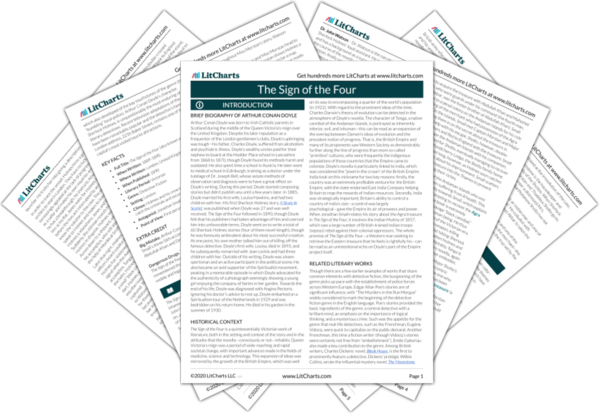Arthur Conan Doyle was born to Irish Catholic parents in Scotland during the middle of the Queen Victoria’s reign over the United Kingdom. Despite his later reputation as a frequenter of the London gentlemen’s clubs, Doyle’s upbringing was tough—his father, Charles Doyle, suffered from alcoholism and psychiatric illness. Doyle’s wealthy uncles paid for their nephew to board at the Hodder Place school in Lancashire from 1868 to 1870, though Doyle found its methods harsh and outdated. He also spent time a school in Austria. He later went to medical school in Edinburgh, training as a doctor under the tutelage of Dr. Joseph Bell, whose astute methods of observation and diagnosis were to have a great effect on Doyle’s writing. During this period, Doyle started composing stories but didn’t publish any until a few years later. In 1885, Doyle married his first wife, Louisa Hawkins, and had two children with her. His first Sherlock Holmes story,
A Study in Scarlet, was published when Doyle was 27 and was well received.
The Sign of the Four followed in 1890, though Doyle felt that his publishers had taken advantage of him and coerced him into unfavorable terms. Doyle went on to write a total of 60 Sherlock Holmes stories (four of them novel-length), though he was famously ambivalent about his most successful creation. At one point, his own mother talked him out of killing off the famous detective. Doyle’s first wife, Louisa, died in 1893, and he subsequently remarried with Jean Leckie and had three children with her. Outside of his writing, Doyle was a keen sportsman and an active participant in the political scene. He also became an avid supporter of the Spiritualist movement, peaking in a memorable episode in which Doyle advocated for the authenticity of a photograph seemingly showing a young girl enjoying the company of fairies in her garden. Towards the end of his life, Doyle was diagnosed with Angina Pectoris. Ignoring his doctor’s advice to rest up, Doyle embarked on a Spiritualism tour of the Netherlands in 1929 and was bedridden on his return home. He died in his garden in the summer of 1930.
